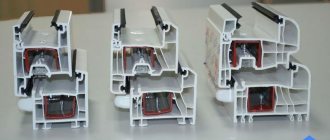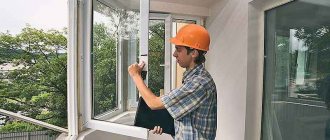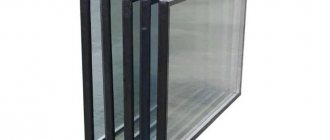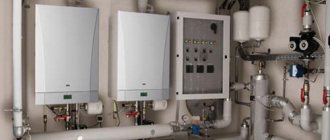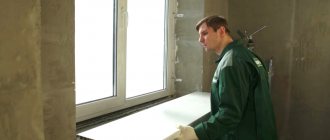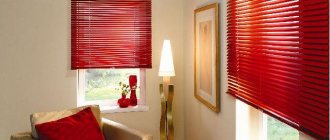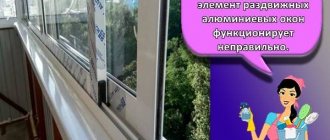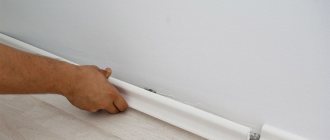Installation of windows in winter - is it possible?
Winter installation of windows was previously impossible, primarily due to the lack of foam with which to work in cold weather.
Since the installation cannot be carried out without this component, all work was carried out only from spring to autumn. The use of foam that hardens at above-zero temperatures in cold weather was guaranteed to lead to a rapid violation of the tightness of the assembly seams.
To solve the problem, a composition was specially developed that sets in frost. This type of foam was called “winter” because it made installation possible at this time of year. The use of frost-resistant sealing material eliminated the dependence on temperature on the streets. Some manufacturers claim that high-quality winter foam with an improved composition hardens even at -20-25 °C. However, for most brands the lower threshold is -15 °C.
To avoid problems after installation, it must be carried out not only using winter materials, but also in compliance with a number of requirements.
At what temperature is it acceptable?
Winter frosts today are not an obstacle to the installation of window structures , since new materials and technologies have appeared that allow this type of work to be carried out in the cold season.
When dismantling and installing windows in winter, polyurethane foam should be used to seal joints, which is designed to perform work at low temperatures.
It contains substances that are resistant to frost. “Winter” foam works well at sub-zero temperatures, down to -15 degrees.- During the procedure for foaming joints, you should use a heat gun. Using this unit, a layer of foam applied from the street is heated. Then the gaps are filled from the inside of the room. The procedure performed in this way guarantees high-quality filling of all voids with foam material.
- If it is planned to replace all the windows in a room, then a phased installation should be carried out: dismantling one old window and immediately installing a new one, and so on, alternately with each window opening.
- Vapor barrier tape (PSUL) can be used at temperatures down to minus 40 degrees. But before using it, the tape needs to be heated with a heat gun (or a hair dryer) so that it expands better. Also, the surface where the tape will be laid must be pre-treated with a primer, therefore, when choosing a product, you should pay attention to the temperature at which it can work.
Installation of windows in unheated rooms
Thanks to winter foam, installation can be carried out in unfavorable conditions.
This greatly simplifies and speeds up the procedure. For example, installing windows in an unheated room in winter does not require pre-heating them if the temperature in them is not lower than +5 °C. This norm is contained in GOST 24866-2014. Moreover, this condition applies to a greater extent to double-glazed windows. If the temperature is below +5 °C, this will cause a change in the shape of the glass, which will bend into the air chambers. This phenomenon is explained by the fact that double-glazed windows are assembled in warm rooms and the air inside them is well heated. Under the external influence of low temperatures, it contracts in the chambers, which leads to deformation of the materials. The glass is pressed inward by atmospheric pressure, resulting in the effect of a concave lens. Sometimes changing the shape of the surface leads to cracking. To prevent damage to window elements, the air must be heated to the required temperature.
Important points
High-quality installation of wooden windows indoors in winter requires the mandatory installation of slopes. They protect the voids that appear between the surface of the opening and the window from moisture and low temperatures.
Foam protects the room well from frost, but it is damaged by moisture and ultraviolet radiation. Without reliable sealant protection, after a month its layer loses its heat-insulating qualities, and in the spring it begins to collapse.
Upon completion of installation, the opening is finished. The slopes need to be insulated; this will not lead to large costs. But it will significantly increase the insulating characteristics of the installed structure.
Features and disadvantages of installing windows in winter
Negative temperatures in any case make adjustments to the installation process. Installing windows in winter is significantly different from performing the same work in summer - it has its own characteristics. If you do not take them into account, you can significantly deteriorate the operational and aesthetic characteristics of structures or even ruin them. Therefore, when installing windows in winter, you need to know exactly what to pay attention to:
- Maintaining the temperature at a stable level
– rooms with open openings instantly cool down, so you need to keep warm. This is done using special screens. They close the openings during installation, so that the temperature in the interior does not drop below +5 °C. - Cooled foam
- if the cylinders are not warmed up before use, the quality of the installation seam may be unsatisfactory. To avoid wasting time during installation, it is recommended to leave the foam overnight in a warm room and not allow it to cool down before using it. - Frozen slopes
- if heated foam is applied to too cold walls, it may also lose its properties. As a result, the likelihood of depressurization of the assembly seam increases. To avoid such situations in severe frosts, it is recommended to warm up the slopes around the perimeter with an industrial hair dryer or a blowtorch. - Fragile plastic
- high-quality installation is only possible when using anchor fasteners that pass through the frames. For this purpose, special holes are drilled in the profiles. In the cold, this procedure may be accompanied by the appearance of chips and even cracks in the plastic. To prevent this from happening, the windows must be kept warm before installation.
Installation of plastic windows in winter is usually carried out before repairs. Experience proves that this is the wrong sequence. After all, new structures can be damaged during other construction work. Construction waste, paint, abrasives and chemicals can cause irreparable damage to frames, sashes, double-glazed windows, fittings and sealing contours.
It is best to cover the openings with plastic film during repairs.
Is it possible to install plastic windows in winter?
Typically, windows are replaced when it is warm - in late spring or summer. But if due to some circumstances replacement is needed in winter, then don’t worry. When using suitable materials, a professional team will carry out the installation no worse than in the summer.
The most common question that arises is whether the heating pipes will burst because the window opening will be open? Here two circumstances must be taken into account. Firstly, the opening does not remain open for long, a maximum of an hour and a half. During this time, the temperature in the apartment drops by approximately five degrees. This is equivalent to intensive ventilation. Secondly, you can roughly determine which month of winter in the region is the warmest. If time allows, plan the installation for this period.
Pros and cons of winter window installation
Installing windows in winter, the pros and cons of which are well known, in most cases has more advantages than disadvantages. However, to achieve a positive result, you must seek the services of only experienced installers. Order fulfillment by newbies or irresponsible professionals can cause one of the serious problems mentioned in the comparison chart.
| Advantages | Flaws |
| Opportunity to save big - during the off-season, prices for both windows and their installation services are reduced | It takes more time to prepare premises for installation than in summer |
| Reduced production time - if in the summer you have to wait up to 2 months for an order to be completed, in winter the time is reduced to 5-7 days | |
| The ability to thoroughly check windows for tightness - due to the significant difference in temperatures outside and indoors, it is much easier to detect the blowing of windows along the perimeter of the installation seam and in the areas where active sashes adjoin | Almost any error during installation can lead to negative consequences - depressurization of seams and even damage to windows |
| Early detection of other defects - in winter it is easier to notice the replacement of energy-efficient double-glazed windows with conventional models, low quality reinforcement and unsatisfactory functionality of fittings | There is a critical dependence on weather conditions, since installation is impossible in severe frosts |
How good is the installation?
How to understand that the windows were installed without violations of technology?
- The glass unit does not fog up and does not freeze.
- There are no drafts from under the frame or sash. When installing windows, they are adjusted and set to seasonal settings. You can check for a draft by holding a lit match or lighter to the window. If the light does not fluctuate or go out, then the sealing is correct.
- The sash opens easily without the use of significant effort, the same applies to switching to ventilation mode.
- When opening or pressing the frame there is no play in the entire system.
- There should be no gaps between the profile and the window opening.
- All joints with sills and window sills are carefully sealed with silicone.
The installer is obliged to check the quality of work and provide warranty service for double-glazed windows.
Also, during operation over a significant period of time (several seasons), the frame should not sag or become loose in the opening. And all the fittings work correctly, without jamming or failure. If there are any violations listed in the list, then you need to contact the installer company . Typically, all manufacturers and installers provide a service guarantee and such defects are eliminated free of charge.
The answer to the question whether it is possible to install plastic windows in winter is yes, but taking into account some nuances. One of them is maintaining temperature conditions. Installation of PVC windows in winter is a more technologically demanding process, but it is possible, just as in summer. In addition, correctly installed plastic double-glazed windows will significantly reduce heating costs.
Use of winter installation materials
Installing windows in winter, reviews of which directly depend on the quality of the work, can be either successful or unsuccessful. To implement the task, it is necessary not only to prepare premises, window units and components, but also to strictly adhere to technology. The installation must be carried out in strict accordance with the standards from the specially developed GOST (these rules can be found in the review on OknaTrade). Much of the final result depends on the correct use of winter installation materials:
Winter foam
Although manufacturers of most formulations indicate an operating range of -15 to -25 °C, the optimal temperature for its use is up to -10 °C.
Before use, the cylinders should be shaken well - the larger the container, the longer this procedure will take. In addition, it must be taken into account that during hardening the foam absorbs a large amount of moisture. In order for the installation seam to set successfully, it is necessary to maintain indoor humidity at 60-95%. To do this, it is recommended to periodically spray water from a spray bottle.
PSUL
The expanding tape can be used in frosts down to -40 °C. Since the lower temperature limit for polyurethane foam is significantly higher, you can safely use this insulating material when installing windows. However, it is necessary to take into account a nuance - before applying PSUL, the surface must be treated with a primer, which may be unsuitable for use in winter. That is, when choosing this composition, you should pay attention to the operating temperature range.
Is it worth replacing windows in sub-zero temperatures? WinAwards Russia 2022 experts advise
There is a common belief that windows should only be installed in the warm season. Modern technologies have reached such a level of development that the influence of the climatic factor is minimized. However, buyers still have doubts. WinAwards Russia 2022 experts will tell you whether it is worth replacing windows at sub-zero temperatures .
Winter installation has already become a common practice for Russian window companies and is not inferior in efficiency to a similar process in the warm season. Of course, working in more extreme weather conditions requires compliance with certain rules and the use of appropriate technologies, as well as frost-resistant installation materials.
Winter window installation is the norm for the Russian climate
Winter installation of windows is a conditional name, since it implies the installation of translucent structures at sub-zero temperatures, which in the varied Russian climate can persist in late autumn and early spring. Thus, the range of this term for some regions is not limited to the December-February season. This type of construction work may be relevant from October to April.
And it is precisely in the coldest climatic zone that people are afraid to change windows due to the uncertainty of obtaining the same quality of structures as those installed in the summer during further operation. The harsh Russian climate is not always a hindrance.
A good example is the massive reglazing of Chelyabinsk in February 2013, when there was a meteor shower that damaged tens of thousands of windows. For the victims of the space anomaly there was no dilemma - to replace the broken windows with new ones or not. More than 5 years have already passed and everyone who had to replace the glazing by chance seems to be happy with the result. This proves that winter window installation is not as scary as many people imagine it to be.
Explanations from experts of the WinAwards Russia 2022, representing various regions of Russia (Moscow, Novosibirsk, Tula region and Krasnodar region), will help you understand: What is better, waiting for the warm season, to continue living in uncomfortable conditions, or to replace old or poor-quality windows at sub-zero temperatures .
Window installation in winter: advantages
Installing window structures in winter is not only possible, but for a number of reasons it is more profitable. Due to the lack of special excitement, orders in winter are completed quickly and within a time convenient for the client. During the installation process, there is a higher probability of immediately identifying and eliminating a possible defect in the construction of the installation seam. Any defect or installation error will be visible immediately (presence of blowing and ice).
6 reasons to replace windows in winter:
1. Delivery times have been reduced . During the cold season, production is usually less busy, so you won’t have to wait long for the structures to be manufactured.
Alexey Snesarev, technical director (Krasnodar) , noted : “In winter, less time is spent on manufacturing products due to the lower production load. For the same reason, delivery will be much faster. In addition, in the cold season, it is more obvious to opt for windows made of a “warm” profile.”
2. The room is not cooled down . Installation technology using a heat shield and the correct sequence provide a non-critical decrease in the room air temperature. A professional installer will complete the work in the shortest possible time.
Alexey Kolesov, technologist at Domkom Group of Companies (Moscow), winner of the WinAwards Russia 2017 , explained: “When installing several structures at a site, they are installed in stages, working alternately with each opening. Unlike installation in the warm season, when all work on the windows is carried out simultaneously, in winter they dismantle them step by step and immediately install a new window in one opening, then move on to the next opening.”
3. Reduced risk of marriage. Since the installation work schedule is less dense, you won’t have to wait long for the installation team; specialists will be able to work slowly, in a relaxed manner, in contrast to the pace of work during the “high season.”
Alexander Morozov, technologist (Tula) , said: “Winter polyurethane foam has a denser consistency, which means your windows will be much more stable. It is also important that window companies do not use temporary workers in winter. The installation will be done by professionals, at a convenient time, slowly and under your control. And you will be able to detect defects by standing near the window for just a couple of minutes (in a draft).”
4. It's easy to spot problems. Installation defects will be detected immediately: blowing, fogging, freezing, icing, etc. can be quickly eliminated. It also allows you to adjust the sash pressure to the most optimal mode.
Anatoly Abalakov, head of the installation and construction department (Novosibirsk), twice winner of the WinAwards Russia 2017 , emphasized : “One of the advantages of winter installation is that it allows you to immediately see whether the window is freezing and fix the identified problem very quickly. This is especially important in cases where not sandwich panels are used for finishing, but the same drywall, for example. You don’t want to have to open the expensive finish later if you find any defects. And during winter installation, a person will immediately be sure that the window does not freeze, so that he can move on to the next stage - finishing.”
5. Economic benefits. Most window companies offer special conditions or a significant seasonal discount for installation in winter. In practice, you can save about 30% on the cost of one window.
“Winter installation has a lot of advantages and bonuses. The time has come for significant discounts and promotions. It’s not surprising - the market is reacting to a significant decrease in demand,” emphasized Alexander Morozov.
6. There is no risk of fraud. Window scammers tend to become active during the peak season for window orders. In winter, they go into hibernation, since the lack of rush demand for PVC windows undermines the very basis of their criminal activity, since it does not allow them to quickly collect an advance payment and disappear with a round sum. During the winter period, only large, financially and morally stable companies do not reduce their activity on the market.
Installing windows in winter: disadvantages
The main disadvantage of winter installation of PVC windows is temperature restrictions. It is recommended to carry out installation at a temperature not lower than –10 °C in an unheated room and –15 °C in a heated room. More time is required for installation due to preparatory work. If a mistake is made and the product is remade, the customer will be forced to remain with the opening open for some time. The most unfavorable conditions for installation are frosty weather, snow, wind, and blizzards.
The expert warned: “In strong winds and snow, windows cannot be installed. Gusts of wind pose a threat to unprotected installation seams (swelling, formation of cracks and bubbles). When working in a room with an open opening, the use of heat guns is prohibited by the fire safety supervision service. In climatic zones where severe frosts are observed throughout the winter, window installation is not recommended. At temperatures below 15 degrees, the elasticity of the seals is lost.”
Many clients are put off by the cold and wind in the house during installation. However, modern technologies make it possible to reduce the adverse effects of external factors in winter. Thanks to the “heat shield” option, it is possible to install PVC windows at lower outside temperatures. And winter polyurethane foam, adapted to a temperature range down to –15 °C, will allow you to create an impeccable installation joint that will not create cold bridges in the future.
“Warm installation is a type of installation in which the opening must be sealed from the outside. A protective screen is installed on the street side, which does not let warm air out of the room, prevents the glass unit from freezing and prevents excess moisture from entering. The use of this technology makes it possible to soften the harsh conditions of the winter season, although it increases the cost of such installation,” the expert said.
It is necessary to replace windows in winter if...
The glass unit is cracked . In this case, there cannot be two solutions. It is natural to replace the double-glazed window, which is not a problem and does not require replacing the entire window. However, in some cases it may be necessary to replace the entire structure. If a PVC window has been in use for a long time, this is a reason to think about completely replacing it, which will increase the functionality of the glazing, since window technology has made great strides forward.
The wooden windows in the house are in disrepair . If in summer you can still put up with such glazing, then in winter it demonstrates all its inconsistency. It is simply impossible to be near the window - it blows cold. As a result, you pay for heating, which escapes through the cracks in the windows, and the family wraps itself in warm clothes and sleeps under three blankets.
You have moved into an apartment with “draft windows ”. Often this dilemma arises among new residents who received the keys to their apartment on the eve of winter or at the end of the year. By delaying the replacement of low-quality glazing, you can find yourself hostage not only to condensation, blowing and freezing, but also to mold. Dealing with the latter can sometimes be very problematic, and during the winter season all the prerequisites are created for its spread throughout the apartment. This can cause great damage to property, not to mention the health of household members.
TIP: If you have doubts about whether it is worth replacing your windows in winter, visit the apartment of your friends or relatives who have high-quality modern windows installed. This will be the best argument in favor of replacing the glazing. Look for friends who have installed plastic windows in winter, find out their impressions, they will help resolve the dilemma.
What should the customer take into account?
The procedure for installing PVC windows in winter is similar to that in the warm season: The only difference is that first the window opening is protected with a heat shield, and then the old frames are dismantled, the opening is prepared for installation, the new window is installed directly, then the slopes are finished.
“The customer must provide free access to the opening and to the electrical networks. To protect furniture and personal belongings from dust, the customer is advised to immediately cover the items with foil or move them to another room. It is best to make slopes warm, that is, use an additional layer of insulation (for example, polystyrene foam or mineral wool). This significantly improves the thermal insulation of the window, while material costs are low. It is not recommended to start constructing slopes immediately after installation; it is better to wait at least a day to monitor the technical nuances of the installation seam and avoid its consequences,” the expert advises.
At the same time, it is necessary to take into account climatic nuances. The structures must be installed some time after delivery, otherwise the PVC frames will undergo deformation due to the low temperature.
Anatoly Abalakov said : “We deliver windows down to minus 25. And this is due precisely to the fact that plastic becomes more fragile in the cold. It is not always possible to notice that a crack has formed in the frame. It can be tiny and disperse, for example, in a year. Therefore, it is better not to take risks and not deliver PVC products to the site at –35-40 °C. Indeed, under such conditions, the frame can easily simply burst - for example, if the car bounces on the same speed bump. There is no universal recipe for how not to damage the structure during delivery and installation. Treat as carefully as possible. And, of course, no one will install the window immediately after delivery: the profile must sit in a warm place for at least a day.”
It takes a little more time to install windows in winter than in the warm season, by about 25-30%. This is due to more thorough preparation of the product for installation. The first and basic rule for installers is to check the conformity of the product and dimensions to the given opening before starting work, so that after dismantling the old window unit, the customer is not left with an open opening at sub-zero temperatures.
“Having arrived at the site, the installers begin by checking the completeness of what was delivered and see if everything was brought to the site. During winter installation, this stage is treated especially scrupulously, since the apartment cannot be left for a long time with the doorway open. In winter, what is missing will be delivered much faster than in summer, since there is no such flow of orders,” explained the head of the installation and construction department of Dinal.
Without following the “winter” technology for installing window structures, it is impossible to obtain a high-quality result. The protective screen and frost-resistant installation materials ensure high-quality installation of windows in winter. Please note that in frosty weather you should use special winter or all-season foam.
The expert warned: “When installing windows in winter, take into account the freezing factor of the walls. At very low temperatures, winter foam does not have the opportunity to expand sufficiently. Insufficient adhesion of foam to a cold surface is undesirable, but special formulations can eliminate this problem.”
Worth reading: WinAwards Russia 2017 experts tell us what ensures “summer” quality in winter window installation
How to make sure that winter window installation was successful?
In winter, it is especially convenient and profitable for customers to check the quality of windows and the installation itself. All the tests are present here: wind loads, low temperatures, freezing rain, snow. Successful installation and good windows are indicated by the absence of blowing, ice, freezing around the perimeter of the installation seam and the window itself, and a warm zone near the window. The use of a thermal imager is not a prerequisite for assessing the quality of product installation.
“It is possible, but not necessary, to use special equipment to determine heat leakage. There are a number of rules that window construction must comply with. Inspect its surface to see if there is any damage on it. Installation seams should be neat and free of bubbles, and the doors should open without effort. Unacceptable flaws - blowing (the seal allows air to pass through), sagging of the sashes, cracks, gaps, movement of the frame profile. Windows should be checked for condensation and drafts. Point out installation errors to window company employees. Sign the acceptance certificate only after these problems have been eliminated,” recommends Alexander Morozov.
The quality of installation work in winter can be assessed using the following criteria:
- There is no blowing from under the frame or sash (you can hold a lit match and watch the flame fluctuate).
- Double-glazed windows do not fog up excessively and do not freeze.
- All accessories work correctly, without failures or jams. The doors open and close without problems and easily switch to ventilation mode.
- When you press on the window frame, there is no play in the entire system.
- There are no noticeable gaps between the profile and the window opening.
- The joints with the ebb and flow sill are carefully filled with silicone sealant.
Typical problems of improper installation of window structures in winter include the presence of drafts, condensation on the glass and freezing. Typically, window companies provide a service guarantee, and such defects are corrected free of charge.
About the Prize
The Russian professional award “Window Company of the Year/WinAwards Russia” will be held for the second time in 2022.
The purpose of the Award is to show the possibilities and directions of development of the translucent structures industry in Russia. Identify and popularize in society the best companies, products, and services on the SEC market. To stimulate the industry towards high-quality professional growth, reliability and responsibility to consumers.
Founder and organizer: Internet portal tybet.ru.
Official partners of the Award: “National Window Union”, NIISF RASN, National Research University “Higher School of Economics”, FIOP (RUSNANO group), “Interregional Window Institute”, NP “Ecological Union” (label “Life Leaf”). Industry partner – International Forum of SPK Manufacturers STiS. With the support of market leaders in window components SIEGENIA, WINKHAUS, profine RUS, Deceuninck and IVAPER.
Official website of the Award https://winawards.ru.
Press center – Liliya Kalashnikova press(а)winawards.ru
Myths about the undesirability of installing windows in winter
The persistent prejudice about the undesirability of installing windows in winter did not arise out of the blue. Its appearance was preceded by the appearance of various myths that seemed quite plausible to consumers. In fact, all of these are misconceptions caused by insufficient information among buyers and have nothing to do with reality:
Myth 1: The room will cool down
This is true, but it is definitely presented in an unfavorable light. If we take a broader look at this problem, then there is nothing wrong with lowering the temperature, since it is not critical. After the installation of windows, which together with the dismantling procedure lasts an hour and a half on average, the rooms do not have time to critically cool down and very quickly warm up to their previous state. After all, the opening remains completely open on average for no more than half an hour. Restoring a comfortable temperature in the room does not require a lot of energy, and taking into account the significant savings on window costs, the buyer is always left with a bottom line profit.
Myth 2: Cold negatively affects materials
If earlier such a statement made sense, since there was no frost-resistant foam, then today the problem is completely solved.
Installation teams have several types of polyurethane foam at their disposal, which can be worked with down to -15°C, and with some brands at lower temperatures. There is another element of window construction that imposes some restrictions on winter window installation - PVC profiles. At temperatures below -20 °C, polyvinyl chloride becomes brittle and is undesirable to handle. This is especially true for economy class models. More expensive profile systems behave much better in severe frost. However, in any case, if you compare these partial restrictions with the properties of the new polyurethane foam, you can draw an unambiguous conclusion - down to -15°C, cold does not have a negative effect on materials, and you can safely install windows.
Myth 3: Workers are cold and in a hurry
This is not true, to be objective, installers are much more in a hurry in the summer, when the day is scheduled literally minute by minute due to the large influx of orders, and there is a lot to do. In winter, they can work calmly and not rush anywhere. This can be considered an additional bonus to the reduced price. Installers simply do not have time to freeze to a critical state and do not have the opportunity, since they are well equipped and are constantly on the move. Since installation is carried out from inside rooms that have not had time to cool, installers usually work at above-zero temperatures and do not experience discomfort.
Skylights and skylights are an exception - it is better not to install them in winter. Such limitations are associated with the technological features of the installation, which is carried out in the roof structure. There is a high risk of leakage, so it is recommended to carry out work in the warm season.
When determining the best time to install plastic windows, the advantages of winter installation should outweigh any disadvantages. Otherwise, the event loses its meaning, and it is unlikely that you will be able to save time and money. If the facility where installation is planned will not be heated and operated for its intended purpose for a long time, it is better to postpone it. After all, premature installation in long-term construction projects often led to the need to order new windows, since previously installed structures had become unusable. That is, an attempt to save money ends up causing serious losses. You should also take note of the recommendation regarding the sequence of installation and repairs in the interior. Taking into account all the nuances mentioned in the article, there are no serious obstacles to carrying out installation in winter.
Additional work
A prerequisite for high-quality installation both in winter and summer will be the finishing of the slopes of the window opening following installation..
Why is this additional work needed? The main function of finishing slopes is to protect the gaps between the window and the opening from temperature changes and moisture. Foam is an excellent sealant and insulator, but it is very sensitive to ultraviolet rays and humidity. If you do not close the gaps, in a month the sealing layer will lose its properties, and by spring it will begin to collapse.
It is better to finish the slopes of a window opening with insulation
After installation work comes finishing work. It is best to make the slopes warm, that is, with an additional layer of insulation (foam plastic, mineral wool). In the schematic drawing you can see one of the options for insulating the internal opening. This is not a very big expense. But in this way the thermal insulation of the window will be improved.
Sequence of checking installed plastic windows
In fact, there is nothing complicated about this, and you should be guided primarily by your subjective feelings. First of all, pay attention to whether the room became significantly warmer immediately after installation. After this, carefully inspect the window to see if everything is done neatly, and if there are any noticeable cosmetic defects that will embarrass you in front of your guests.
Make sure that there are no noticeable scratches on the glass and the plastic itself, and that the frame is not deformed. Of course, the polyurethane foam should not protrude anywhere, because it itself does not look particularly aesthetically pleasing, and in addition, over time it can acquire a brown tint. Remaining foam must be thoroughly cleaned both inside and outside.
To check the quality of installation of fittings, you should make sure that the window sashes open easily and their movement is sufficiently soft in any operating position. To check the tightness of the fit, you can clamp an ordinary sheet of paper with the window sash and make sure that it is clamped well enough and cannot be pulled out.
If you have the skills to use a level, be sure to measure the quality of the installation using it. In addition, the contract must stipulate that the company undertakes to correct all defects discovered during operation at its own expense.
After a few days, you should carefully inspect the inside of the frame in good light. Even a slight coating of dust indicates that the seal of the window has been broken somewhere nearby.
Where to start preparing for window replacement?
The first step, of course, is to measure the window openings. In any case, a company specialist will come to take measurements again, but approximate data will help you get a better price. With a specialist who comes to measure the windows, you can also discuss options for the structural design and design of the window that best suits you.
When all organizational issues have been resolved, a company has been selected, a contract has been concluded and a date has been set for installation, some preparation should be made in order to optimize this process as much as possible. Many of these things are often forgotten. Here is a list of what you should do first to avoid fuss while working:
- Prepare a place to work, remove all unnecessary things;
- Protect the floor finish by laying down thick paper or a cover;
- Close interior doors (from cold and dust).
Suitable temperature: how many degrees is it acceptable to set?
Manufacturers of PVC windows calculate window structures in such a way that they function normally at high/low average Russian air temperatures and relative humidity. For Moscow, these characteristics are +26.3/-15C and 95%, respectively.
This is due to two reasons - the use of consumables: foam, sealants and self-expanding tape, which are designed for their temperature range and the behavior of structural materials and window elements in different temperature conditions.
During the winter season
The minimum winter temperature for installing PVC windows is -15C outside the room and +5C inside. At lower temperatures, the glass unit may crack, and the PVC elements will become brittle; if handled carelessly, they may collapse.
Consumables for installing PVC windows in winter:
“Makroflex” winter foam up to -15 C, excellent adhesion, low secondary expansion, price - 970 rub./piece.- “Soudal” winter foam up to -15C, without toxic additives, odorless, fine-porous and dense structure, cost - 292 rubles / piece.
- “Penosil” winter foam down to -15C, practically odorless, low secondary expansion, high foam yield, price - 665 rubles/piece.
- “Titan” winter foam up to -15C, non-toxic, without shrinkage and with good adhesion, price - 375 rubles / piece.
- Silicone sealants with a working temperature of -50C:
- Belinka Belsil - 300 rubles;
- Ceresit CS 25-150 rub.
- Robiband RF tape PSUL, 6 m - 144 rub.
Spring/autumn
This is the best option for installation. The materials used for installation are called non-seasonal , the permissible temperature of the outside air is -5 to + 20 C, and the inside temperature is above + 5 C.
- Consumables for installing PVC windows in the spring-autumn period: “Moment-installation” off-season foam, temperature range -5 to +20C, good adhesion, dense, homogeneous, tolerates finishing well, price 250 rubles / piece.
- Acrylic sealants with operating temperatures from -5 to 20C:
- Makroflex FA131, Germany - 360 rubles;
- Dow Corning 7091, USA - 1500 rub.
- Polyurethane mixtures:
- TYTAN PROFESSIONAL PU 40, Poland - 700 rubles;
- Dow Corning, USA - 1800 rub.
- Robiband RF tape PSUL, 5.6 m - 290 rub.
In summer
Summer temperatures have a maximum limit of +35C. this is due to the fact that due to thermal expansion, the windows will behave unpredictably, for example, the sashes will not be able to close or the fittings will not function.
In this temperature regime, it is impossible to perform the correct post-installation adjustment of such a window. Therefore, if it happens that it is necessary to install a PVC window during high summer temperatures, you need to choose morning or evening hours for installation, when the mercury column on the thermometer is below 35C.
Consumables for installing PVC windows in summer:
- Stroypena:
- Makroflex, 750ml, price - 800 rubles;
- TYTAN Professional, price - 360 rubles;
- Penosil Max /Premium/PRO, 750 ml price - 500 rub.;
- Makroflex ShakeTec, 750 ml. price - 1500 rub.
- Polyurethane sealant, used at temperatures above +35C:
- “Moment” 600 ml, price - 460 rubles;
- “Izhora” 12.5 kg, price - 2188 rubles;
- Olin 600 ml, price - 200 rubles;
- Retel 310 ml, price - 110 rub.
- Robiband RF tape PSUL, 6 m - 144 rub.
Santa Claus is your expert
A significant nuance of winter installation of plastic windows is the independent examination of Santa Claus. In the winter season, defects in the opening are clearly visible (when taking measurements, you can take into account the complexity of the upcoming installation), and during installation, assess where it is necessary to additionally insulate and insulate the window opening, identify the quality of the work performed (whether the house has become warmer). If the window installation was not carried out by professionals, then you will immediately notice that your windows are being blown out or ice is forming on the glass unit.
